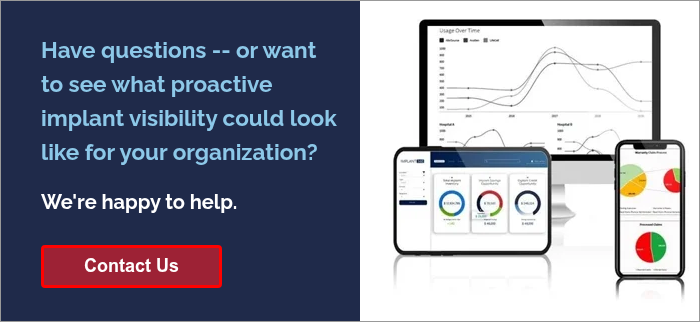Proactive Implant Visibility: How Hospital Leaders Prevent Risk System-Wide
by Tracey Berkowitz on October 16, 2025

Every hospital leader responsible for implant inventory performance knows the frustration -- the last-minute scrambles, the uncertainty before a critical procedure, the constant chase to understand why something went wrong after the fact.
You can't fix what you can't see.
When reporting is fragmented, retrospective, and limited to a single facility, management teams are left piecing together what happened last quarter instead of anticipating what's next. Without system-wide visibility, preventable risks -- from expirations, stockouts, and shortages to recall exposure -- quickly turn into waste, loss, and unnecessary spend before anyone can take action to prevent them.
From Reactive Reporting to Proactive Visibility
To stay ahead, hospital systems need predictive insights and scalable visibility to identify risks before they turn into costs or compromise care. Traditional reporting explains what went wrong last quarter, but to manage implant performance effectively, leaders need visibility that's forward-looking and right-sized -- scaled to their organization, whether a single facility, across a regional division, or an entire health system. System-wide visibility shows what's at risk today, so leaders can prevent tomorrow's loss.
Implant360 Analytics -- an essential add-on to InVita's UDITracker -- gives leaders predictive insight and scalable visibility to control cost and prevent risk. Acting as a centralized control tower, it consolidates data into one real-time view that tracks spend and flags shortfalls by product or location, delivering insights straight to inboxes in time to act.
It's not just about seeing what happened -- it's about seeing what's next -- and acting before risks become costly consequences.
Here's how proactive, right-sized implant visibility works in practice.
Expiration Risk: Focus Where It Matters Most
Expiration remains one of the most persistent and costly challenges in implant management. Most systems generate broad 30-, 60-, or 90-day lists of implants, set to expire within that window, treating every item the same and flooding staff with alerts instead of highlighting the implants that pose the greatest financial or clinical risk.
Implant360 Analytics changes that. By combining multiple data points, it ranks implants by both financial exposure and expiration urgency, enabling teams to focus on the high-priority items first, preventing waste, protecting budgets, and optimizing resources across the system.
Stockout and Shortage Prevention: Stay Ahead of Demand
Few things disrupt care -- and cost more -- than discovering an implant shortage too late. Rush orders, expedited shipping, and delayed surgeries add unnecessary expense and stress.
With Implant360, hospital leaders receive insights comparing on-hand inventory to real-time usage across all facilities. When low stock is flagged, teams can reallocate implants between facilities before any disruption occurs.
The result? Continuous supply, uninterrupted procedures, and avoided costs -- all driven by visibility that's proactive and right-sized to their system's scale.
Recall Exposure: Act Fast, Protect Patients
When a recall hits, every second counts. Manual searches across facilities waste time and risk patient safety.
Implant360 pinpoints recalled items instantly, identifying affected products and their exact storage locations so teams can act with precision, protecting patients without losing hours to manual searches.
Implant Insights Delivered Straight to Decision-Makers
Hospital leaders don't have time to log into systems or refresh dashboards. With automated threshold alerts and scheduled reports, Implant360 delivers critical implant inventory insights directly to stakeholders' inboxes, cutting through noise so the right people act in time.
Thresholds can be configured by product and location to monitor expiration and stockout risks, ensuring supply continuity, balanced inventory, and waste prevention, without constant logins or manual oversight.
Beyond Risk: Turning Analytics into Strategic Advantage
Preventing risk is only part of the story. With system-wide visibility, hospital leaders can also see spend and performance more clearly, identifying cost drivers, tracking trends across facilities, and uncovering opportunities to optimize resources and supplier partnerships.
That's how Implant360 Analytics extends its impact beyond risk prevention -- transforming implant visibility from a nice-to-have to essential infrastructure that helps hospitals anticipate and prevent issues before they impact operations, cost, or care.
Seeing Implant Risk Before It Costs You
The line between readiness and risk often comes down to what teams can see -- and when. A single missed alert or unanticipated shortage can ripple through surgeries, budgets, and patient care. But with proactive, right-sized visibility, hospital leaders can forecast demand, optimize stock levels, and prevent waste and unnecessary spend -- while there's still time to act.
No guesswork. No scrambling. No surprises.
That's the power of Implant360 Analytics -- visibility you can act on, before it's too late.
- Implant (5)
- Analytics (4)
- Implant360 (4)
- Non-biologic Implants (4)
- Implant Management (3)
- Expiration Date Management (2)
- Explant (2)
- RFID (2)
- non-biologics (2)
- Administrative Burden (1)
- Data Integrations (1)
- Implant Case Documentation (1)
- Implant Case Management (1)
- Joint replacement tracking (1)
- Medical Device Recalls (1)
- Process Breakdowns (1)
- RFID Device Management (1)
- Stockouts and Shortages (1)
- UDITracker VistA Integration (1)
- VA Facilities (1)
- VistA Interface (1)
- Warranty Claims Management (1)

